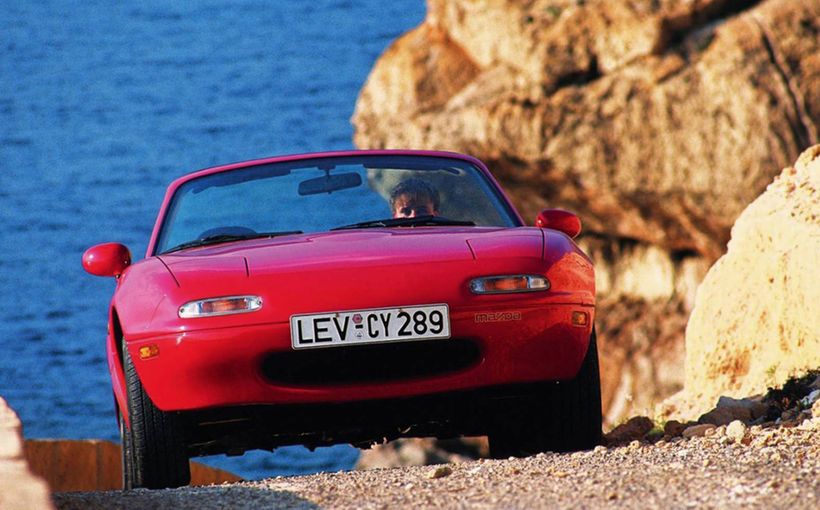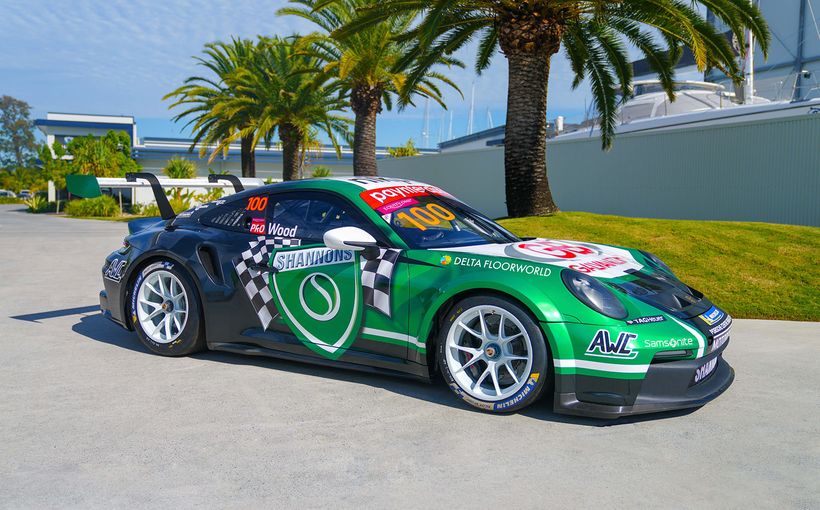MAZDA RX-7 SERIES IV: Superior RX-7 or the first Japanese Porsche?

The original Mazda RX-7, which made its debut on 30 March 1978, was always going to be a tough act to follow. It quickly became the best selling sports car Japan had ever seen and reversed the dubious reputation of rotary-engined Mazdas in the US. But for all its brilliance, it had shortcomings which were increasingly evident by mid-1981 when serious work began on planning its successor, the ‘P747’ RX-7, which we think of locally as the ‘Series IV’.
Toyo Kogyo (as Mazda was then known) had created a new market niche but senior suits knew that rivals would be forthcoming from Nissan, Toyota and Honda, and Mitsubishi’s unfortunately named Starion was imminent. After just three years, the RX-7’s live-axle rear suspension, rear drum brakes, 13 X 4.5-inch steel road wheels and somewhat vague recirculating ball steering seemed to mark it as a car of the 1970s rather than the more extravagant ’80s.
Three different concepts were considered. The most modest was called the Realistic Sports car, which was essentially an updated version of the original RX-7, adding rack and pinion steering but little else. Concept Two was the Technologically Advanced Sports car with gear such as active suspension, Porsche-like transaxle and 14-inch wheels. It was to be a 2 + 2 rather than a 2-seater. Concept Three (definitely not to be confused with the lamentable Morris 1500 of 1969 which was promoted under the same heading) was the Civilised Sports Car.

The third concept fitted between the other two. It would have advanced independent rear suspension, 2 + 2 seating, a longer wheelbase but no advanced chassis electronics. Quickly, this concept got the nod.
The feeling in management circles was that an evolution of the old model would have been quickly outdated by nimble newcomers. (Think how old the RX-7 Series Three seemed in comparison with the Honda CR/X and the Toyota MR2!)
As for the Technologically Advanced concept, management felt it was too futuristic and would blow the purchase price out too far.
Having established the RX-7 as desirable yet affordable, the Toyo Kogyo designers had no intention of departing too radically from the concept. What they wanted was a better RX-7 that would still attract custom from those who had bought the original.
So there was a need to retain strong linkage. Previous rotary-engined Mazdas showed a linear progression of nomenclature, from the time the RX-2 supplanted the R100. So we got RX-3, RX-4 and RX-5 with no RX-6 because it was felt that this name did not trip off the lips elegantly. There was thought given to ‘RX-8’, ‘RX-11’ and ‘RX-7’. Finally, the proponents of retaining the old name, headed by Chief Project Engineer, Akio Uchiyama, won this argument.
In his coffee table volume, RX-7: The New Mazda RX-7 and Mazda Rotary Engine Sports Cars, Jack Yamaguchi tells why the new car kept the old name:
The rationale was that the RX-7 had become a household word, particularly in the all-important American market, that would continue to strike the right note with the world’s enthusiasts. Further, reasoned the ‘7’ proponents, if the car is good, the name should be good; if the breed improved, the established name would take on the intended connotation of newness and increased product value.
… the development code P747 has no particular meaning; it was chosen by Uchiyama so as not to give any hint about the vehicle’s type, year, configuration or engine type.
Toyo Kogyo’s product planners knew the RX-7 as envisaged in Civilised Sports Car mode would head towards Nissan ZX territory. But they were never going to let it stray too far in what they regarded as the wrong direction; the 280ZK seemed obese and unathletic compared with its 240Z predecessor. They even hoped to bring the new car market no heavier than its predecessor. In the end, the entry level P747 weighed 1190kg to the old car’s 1140, which was a great outcome considering how much more technology it boasted.
Today 1140kg seems amazingly light. The engineers used alloy extensively. Bonnet, front suspension arms, the engine mount bracket, front brake calipers and even the jack were alloy, the last-mentioned feature saving 1.3kg.
Given the design parameters the weight was well contained and, importantly, it was more evenly distributed. The old car had been markedly nose-heavy with 54 per cent of its mass hung over the front wheels. By contrast, the new RX-7 complete with two occupants and a full tank of fuel achieved the magical 50:50 figure.

If the old car had been the first viable Japanese alternative to a Porsche, then its successor was even more obviously inspired by the products of Zuffenhausen. From this distance in history it now seems fair to call it Japan’s answer to the Porsche 944, the chief car against which it was benchmarked.
Nowadays virtually every new European and Japanese performance car is tested at the old Nürburgring, the most formidable circuit in the world and an immense 21 kilometres long. But when Toyo Kogyo invited 1960 Le Mans winner, Paul Frère, to test the prototype P747, that was a high point of the itinerary. ‘For me,’ said Frère, ‘it [the Nürburgring] is a wonderful basis of comparison, since I have driven there for more than 30 years, completing nearly 2000 laps racing and testing cars ranging from Formula 1 to family models.’

True, the famous racer and motoring journalist was on the Toyo Kogyo payroll but he didn’t need to go so far as to describe the handling as ‘so precise, so crisp and responsive that it felt nearly like a racing car.’
Frère’s praise of the performance was more restrained. To make up for the increased weight, Toyo Kogyo’s engineers decreed that the 13B rotary would be standard on the new car. Unfortunately, all the extra capacity was absorbed to retain the same level of performance as achieved by the earlier model: hardly progress. ‘Naturally,’ said Frère, ‘my preference goes to the turbocharged version, which has enough power to do justice to the wonderful chassis – especially as the turbo is effective at quite low engine speeds and its response is not far short of immediate.’ In other words, the standard car was underpowered for its chassis!
Well I remember my own surprise at finding the car many people were describing as the ‘Porsche-style RX-7’ recorded the same time though the 400 metres test as its predecessor – an even 17 seconds, hardly fast even back in 1986. In fact the P747 RX-7 was only a few tenths quicker over this yardstick sprint than the Nissan Pulsar ET Turbo and much slower than the VL Commodore Turbo! The turbocharged version of the RX-7 lagged four months behind the naturally aspirated edition in arriving on Australian new car price lists.
The Toyo Kogyo (TK) designers had a big say, asking the engineers to incorporate such features as steeply raked A-pillars, mudguard blisters, and as narrow as possible a gap between the tops of they tyres and the guards. They also wanted to be able to promote a CD factor of less than 0.30 (the benchmark hypothetically set by the 1982 Audi 100, whose real-world figure was more like 0.32). Flush door handles, hidden drip rails (a-la said Audi) and a one-piece glass pane integrating the rear window and quarter lights and a short rear overhang were other wish-list items which made their way into the production car. The actual drag figure was 0.31 for the base car with twin streamlined mirrors.


In the 1986 Australian context the new RX-7 faced a big challenge. The price expressed in rapidly deteriorating $A terms skyrocketed. The premium Series III had retired at around $27K but even the cheapest variant of the new car, known as the ‘Sports’ asked $39,470. When the Turbo lobbed, the ask was a whopping $50,330, not much short of double the previous topline Series III.
At least there was no querying the urge. In late 1986 the RX-7 Turbo had few peers, cutting through the 400 metres in 15.4 seconds. But the magic of this car was not indicated on a stopwatch. Here, finally, was the definitive rotary Mazda. The 1969 R100 and subsequent sedan-based ‘RX’ cars had ordinary dynamics with super grunt. The first RX-7 handled pretty well but never really had quite enough performance. The P747 in non-turbocharged guise handled superbly but didn’t go hard enough.
By complementing the ferocious top-end power which is key to the Wankel rotary engine’s allure with a turbocharger’s massive mid-range thrust, the TK engineers gave sports car lovers the best of both worlds. All rotary Mazdas were unique; the RX-7 Turbo was uniquely appealing.

The real advantages of the clever new independent rear suspension became more apparent. Christened the Dynamic Tracking Suspension System (DTSS), it incorporated a triad-pivot floating hub that controlled each wheel’s toe attitude under specific load conditions and a multi-link/pivot arrangement that compensated for camber changes and provided anti-dive and anti-squat effects.
Simply put, under mild cornering conditions the rear wheels exhibited mild toe-out, which aided turn-in. Press hard, however, and the hub assumed a toe-in attitude, the degree of which depended on the wheel loading. In practice, these responses made for a car that seemed eager to help the driver around a corner. In essence, this was TK’s first step towards four-wheel steering which would later be introduced into some Mazdas (even though hindsight now suggests 4WS was a fad).
Another new feature was the automatically adjustable shock absorber system (bearing the uncharismatic acronym AAS). TK had pioneered this idea for mass-production cars in the days of the first front-wheel drive 626-cum-Ford Telstar. The system had been considerably refined for the P747 RX-7. For example, with the setting on Sport, the shocks remained in ‘firm’ mode for all straightline constant speed driving but checked roll, dive and squat automatically.
In 1989 the RX-7 Turbo II went on sale. The Mazda’s superiority over its rivals had been showcased in the previous year’s Winton 300 production car endurance race. Now, it was quicker again with the standing 400m down from 15.4 to an even 15 seconds, which was pushing down towards XY Falcon GTHO country! But which do you reckon would have triumphed at Bathurst? OK, it’s not quite fair to compare a 1971 Ford with a 1989 Mazda rotary sports car.

Testing a Turbo II, I was more than a little impressed. Driving home from Canberra to Sydney one summer afternoon, I was exhilarated by the immediate lag-free power, the absolute (Nürburgring-honed) responsiveness of the chassis and the comfort of the cabin. The P747 had never been intended as a luxury car but it did such a good job of catering to its occupants that I found myself questioning the value of so-called ‘luxury’.
In summary, the Series IV Mazda RX-7 soon earned the description ‘Porsche-like’. This proved to be a mixed blessing. Even though the P747 was a much better car dynamically than its predecessor, some charm and character had been sacrificed in emulating the famous German marque. (And no-one at either Mazda or Porsche could have known in the early 1980s that front-engined Porsche sports cars would soon be a thing of the past!)









